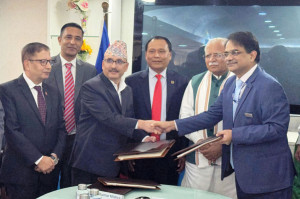Money
External debt swells as rupee plummets
Nepal’s external debt swelled by Rs30 billion in the first half of the fiscal year as the Nepali rupee plunged against the US dollar and special drawing rights
Nepal’s external debt swelled by Rs30 billion in the first half of the fiscal year as the Nepali rupee plunged against the US dollar and special drawing rights (SDR), the currencies in which foreign loans are obtained, the Financial Comptroller General’s Office (FCGO) said.
Nepal receives foreign loans in both US dollars and SDR, a supplementary reserve currency created by the International Monetary Fund. Multilateral donor agencies usually use SDR for extending loans. The FCGO, which maintains records of the government’s income and expenditure, said that external debt increased by Rs30.84 billion to Rs374.10 billion as of January 14, representing a 9 percent growth. The Nepali rupee depreciated to Rs107.20 per US dollar on January 14.
Meanwhile, internal debt fell 7.7 percent to Rs186.06 billion. The country’s total debt as of January 14 stands at Rs560.17 billion, with external loans making up 67 percent.
“As no internal loan has been issued till the second quarter of this fiscal year, domestic debt has come down,” the FCGO said. The government also made early repayment of some domestic loans.
The government has adopted a policy of making payments against treasury bills early in the year instead of allowing them to roll over. Treasury bills are a type of debt instrument to which Nepal Rastra Bank (NRB) and banks and financial institutions subscribe. As part of the plan, the government paid over Rs5 billion to the central bank against its treasury bills during the first quarter.
FCGO officials said that the government had decided to repay its debts early in the fiscal year to avoid criticism that it spends most of the capital budget in the last quarter. The government had repaid domestic debts amounting to Rs18.29 billion as of the first half of the current fiscal year. Repayment of external debts reached Rs10.24 billion.
The government had received external loans totalling Rs22.66 billion as of the first half of the current fiscal year. Multilateral donors provided Rs21.89 billion (97 percent) while the rest came from bilateral donors. The government has more foreign loans than domestic loans, but the interest rate on external debt is lower.
External debt consists of only soft loans from donors while the government has to pay a higher rate of interest to attract buyers of domestic debt instruments. The government paid Rs1.59 billion in interest to foreign creditors and Rs2.7 billion in interest to domestic creditors.
Of the total external debt, Nepal owes Rs338.79 billion to multilateral donors like the World Bank and Asian Development Bank and Rs35.3 billion to bilateral donors.




 19.12°C Kathmandu
19.12°C Kathmandu














